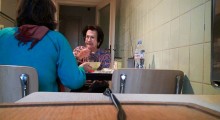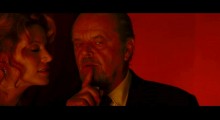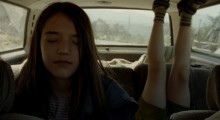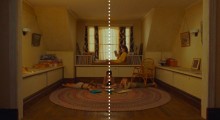Video Essay
-
What is a Video Essay? Creators Grapple with a Definition

Perhaps video essays are like pornography in that, as the saying goes, you know it when you see it. But what distinguishes a video essay from a short film and what are the ground rules for this relatively new form? Finally, how much creative leeway can a video essayist take with a filmmaker’s work without being disrespectful or misrepresentative? These questions arose last month when we published a video essay from Kevin B. Lee, chief video essayist at Fandor, about the spaces in Chantal Akerman’s final documentary, No Home Movie. Initially, Lee edited the video to music. But after receiving some complaints, including from the distributors […]
by Paula Bernstein on May 3, 2016 -
Watch: Inside the Rooms of No Home Movie, Take 2

Late last week, we published a video essay from Kevin B. Lee, chief video essayist at Fandor, about the spaces in Chantal Akerman’s final documentary, No Home Movie. Lee estimated that about 70% of the film took place within the walls of the filmmaker’s dying mother Natalia’s apartment. To re-orient himself in Natalia’s apartment, Lee reorganized the footage by room. Initially, he edited the video to music, using Schubert’s Impromptu D. 899 Op. 90 No. 3, not coincidentally the same music used in Michael Haneke’s Amour, which also follows an elderly woman’s demise. But after receiving some complaints, including from the distributors of the film, Lee reassessed […]
by Paula Bernstein on Apr 5, 2016 -
Watch: No Home Movie Room by Room

Chantal Akerman’s final film, No Home Movie, takes on a deeper resonance following the Belgian filmmaker’s death in October 2015. The film is a documentary tribute to her dying mother, Natalia a.k.a. Nelly and an exploration of their relationship. As with all of Akerman’s work, there’s a deeply autobiographical element to the film — even more so now that we know it was to be her last. In the above video essay from Fandor, Kevin B. Lee has reorganized the film’s footage by each room in the apartment to emphasize how Akerman explores each space to reflect her relationship with her dying mother. Beginning April 1, No Home Movie […]
by Paula Bernstein on Mar 31, 2016 -
Watch: What is “Lynchian”?

What defines the unmistakeable cinema of David Lynch? This recent video essay explores this question, using text from David Lynch: The Man from Another Place, the new book by Dennis Lim. “The paradox of the Lynchian sensibility is that it is at once easy to recognize and hard to define,” intones Kevin B. Lee in What is “Lynchian”? over at Fandor Keyframe. From the quaint small towns of Twin Peaks and Blue Velvet where darkness lurks beneath the surface to the haunted Los Angeles nightscapes of Lost Highway and Mulholland Drive, Lynch’s films find skewed perspectives on familiar settings. Returning to certain indelible images, Lynch has mined the same themes […]
by Paula Bernstein on Dec 16, 2015 -
Watch: The Tarantino Death Toll

Ever wonder how many people have died in Quentin Tarantino films? Or what’s behind the director’s seeming obsession with killing? Kevin B. Lee, Chief Video Essayist at Fandor, has tackled the bloody topic with a video essay on the body count in Tarantino’s films. Note the video’s warning: “the following video contains disturbing imagery of extreme violence and death.” In the text essay that accompanies the video (which you can watch above), Lee explains that he created this video after the release of Tarantino’s last film, Django Unchained, but this is the first time it’s being published (read the essay to understand […]
by Paula Bernstein on Dec 16, 2015 -
Watch: Red Lighting in the Films of Martin Scorsese

A new site called Film Scalpel is devoted to not just the production of video essays, but also understanding their grammar and exemplary practitioners. Among their first handful of videos are four takes on different motifs in the work of Martin Scorsese, with a thoughtful look at his use of red as it historically relates to tinting and black and white compositions. Check that out above, and read below for some context. Just as silent movies were rarely silent, black-and-white films were not often simply black and white. In the silent era, the techniques of tinting and toning were commonly used to add a dash of […]
by Sarah Salovaara on Sep 2, 2015 -
Watch: Diametric Composition in Two Days, One Night

Jean-Pierre and Luc Dardenne are consistently lauded for their naturalistic brand of social realist dramas, but this video essay from Marshall Shaffer digs a little deeper, putting forth Two Days, One Night as an argument for the brothers’ masterful (and largely undiscussed) use of composition. Through varied backdrops and physical obstacles, the brothers repeatedly cleave their frames in two, reflecting the emotional discord between Sandra (Marion Cotillard) and her co-workers. The favoring of subtle and organic barriers, Shaffer argues, provides a nice contrast to the exacting compositions of Kubrick, Anderson, and other directors who are frequently cited as the gold standard.
by Sarah Salovaara on Aug 27, 2015 -
Watch: How to Shoot a Road Movie

The road movie is a frequently tread subgenre, rife with comedic, episodic and dramatic potential. It can also pose a challenge for those seeking a varied mise-en-scene, and in this deconstruction of Dominga Sotomayor’s Thursday Till Sunday, Kevin B. Lee looks at the 83 ways in which the characters are framed in their rather contained environment. It’s a good primer on how to read a scene’s construction, and, from a directorial stand point, how to keep a static environment fresh.
by Sarah Salovaara on Aug 20, 2015 -
Watch: The Evolution of Chuck Jones

Before Pixar, there was Warner Brothers — or more specifically, there was Chuck Jones. The latest in Tony Zhou’s “Every Frame a Painting” series examines how the animator utilized discipline and restrictions to create his iconic cartoons; how he enmeshed character traits into a simple comedic games of assumption and reality; how minimalism was his strong suit and more.
by Sarah Salovaara on Jul 16, 2015 -
Watch: Parallels in the Work of Yasujiro Ozu and Wes Anderson

At first blush, the filmmakers Yasujiro Ozu and Wes Anderson would appear to have little in common, but this video essay from Anna Catley attempts to look past the more superficial aspects of their respective oeuvres to find striking and surprising similarities. From symmetrical frames to a faithful allegiance to familial strife and more in between, the filmic parallels are far more numerous than you may expect.
by Sarah Salovaara on Jul 14, 2015










